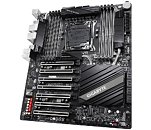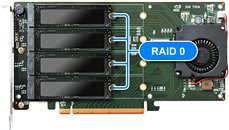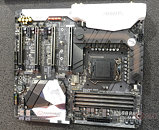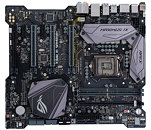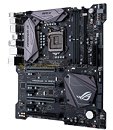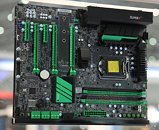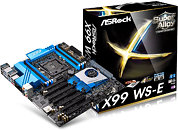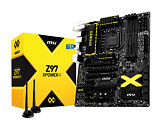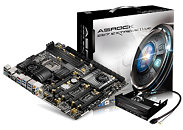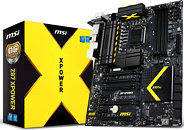Apr 13th, 2025 15:09 EDT
change timezone
Latest GPU Drivers
New Forum Posts
- Optical Disc Drive owners club (198)
- How to relubricate a fan and/or service a troublesome/noisy fan. (217)
- SK hynix A-Die (Overclocking thread) only for RYZEN AM5 users (30)
- Regarding fan noise (5)
- RX 9000 series GPU Owners Club (309)
- Overclocking Micron F-die RAM (0)
- What are you playing? (23376)
- What is going to be your next tech upgrade? just curious :) (37)
- best ram to buy for my usage and system specs? (18)
- Dell Latitude 5420 - i7 1185G7 (2)
Popular Reviews
- Thermaltake TR100 Review
- The Last Of Us Part 2 Performance Benchmark Review - 30 GPUs Compared
- TerraMaster F8 SSD Plus Review - Compact and quiet
- ASUS GeForce RTX 5080 TUF OC Review
- Zotac GeForce RTX 5070 Ti Amp Extreme Review
- ASRock Z890 Taichi OCF Review
- Sapphire Radeon RX 9070 XT Pulse Review
- Sapphire Radeon RX 9070 XT Nitro+ Review - Beating NVIDIA
- Upcoming Hardware Launches 2025 (Updated Apr 2025)
- AMD Ryzen 7 9800X3D Review - The Best Gaming Processor
Controversial News Posts
- NVIDIA GeForce RTX 5060 Ti 16 GB SKU Likely Launching at $499, According to Supply Chain Leak (181)
- MSI Doesn't Plan Radeon RX 9000 Series GPUs, Skips AMD RDNA 4 Generation Entirely (146)
- Microsoft Introduces Copilot for Gaming (124)
- NVIDIA Sends MSRP Numbers to Partners: GeForce RTX 5060 Ti 8 GB at $379, RTX 5060 Ti 16 GB at $429 (123)
- Nintendo Confirms That Switch 2 Joy-Cons Will Not Utilize Hall Effect Stick Technology (105)
- Over 200,000 Sold Radeon RX 9070 and RX 9070 XT GPUs? AMD Says No Number was Given (100)
- Nintendo Switch 2 Launches June 5 at $449.99 with New Hardware and Games (99)
- NVIDIA PhysX and Flow Made Fully Open-Source (77)
News Posts matching #PLX
Return to Keyword Browsing
NVIDIA to Showcase AI-generated "Large Nature Model" at GTC 2024
The ecosystem around NVIDIA's technologies has always been verdant—but this is absurd. After a stunning premiere at the World Economic Forum in Davos, immersive artworks based on Refit Anadol Studio's Large Nature Model will come to the U.S. for the first time at NVIDIA GTC. Offering a deep dive into the synergy between AI and the natural world, Anadol's multisensory work, "Large Nature Model: A Living Archive," will be situated prominently on the main concourse of the San Jose Convention Center, where the global AI event is taking place, from March 18-21.
Fueled by NVIDIA's advanced AI technology, including powerful DGX A100 stations and high-performance GPUs, the exhibit offers a captivating journey through our planet's ecosystems with stunning visuals, sounds and scents. These scenes are rendered in breathtaking clarity across screens with a total output of 12.5 million pixels, immersing attendees in an unprecedented digital portrayal of Earth's ecosystems. Refik Anadol, recognized by The Economist as "the artist of the moment," has emerged as a key figure in AI art. His work, notable for its use of data and machine learning, places him at the forefront of a generation pushing the boundaries between technology, interdisciplinary research and aesthetics. Anadol's influence reflects a wider movement in the art world towards embracing digital innovation, setting new precedents in how art is created and experienced.
Fueled by NVIDIA's advanced AI technology, including powerful DGX A100 stations and high-performance GPUs, the exhibit offers a captivating journey through our planet's ecosystems with stunning visuals, sounds and scents. These scenes are rendered in breathtaking clarity across screens with a total output of 12.5 million pixels, immersing attendees in an unprecedented digital portrayal of Earth's ecosystems. Refik Anadol, recognized by The Economist as "the artist of the moment," has emerged as a key figure in AI art. His work, notable for its use of data and machine learning, places him at the forefront of a generation pushing the boundaries between technology, interdisciplinary research and aesthetics. Anadol's influence reflects a wider movement in the art world towards embracing digital innovation, setting new precedents in how art is created and experienced.

GIGABYTE Unveils Next-gen HPC & AI Servers with AMD Instinct MI300 Series Accelerators
GIGABYTE Technology: Giga Computing, a subsidiary of GIGABYTE and an industry leader in high-performance servers, and IT infrastructure, today announced the GIGABYTE G383-R80 for the AMD Instinct MI300A APU and two GIGABYTE G593 series servers for the AMD Instinct MI300X GPU and AMD EPYC 9004 Series processor. As a testament to the performance of AMD Instinct MI300 Series family of products, the El Capitan supercomputer at Lawrence Livermore National Laboratory uses the MI300A APU to power exascale computing. And these new GIGABYTE servers are the ideal platform to propel discoveries in HPC & AI at exascale.
Marrying of a CPU & GPU: G383-R80
For incredible advancements in HPC there is the GIGABYTE G383-R80 that houses four LGA6096 sockets for MI300A APUs. This chip integrates a CPU that has twenty-four AMD Zen 4 cores with a powerful GPU built with AMD CDNA 3 GPU cores. And the chiplet design shares 128 GB of unified HBM3 memory for impressive performance for large AI models. The G383 server has lots of expansion slots for networking, storage, or other accelerators, with a total of twelve PCIe Gen 5 slots. And in the front of the chassis are eight 2.5" Gen 5 NVMe bays to handle heavy workloads such as real-time big data analytics and latency-sensitive workloads in finance and telecom.
Marrying of a CPU & GPU: G383-R80
For incredible advancements in HPC there is the GIGABYTE G383-R80 that houses four LGA6096 sockets for MI300A APUs. This chip integrates a CPU that has twenty-four AMD Zen 4 cores with a powerful GPU built with AMD CDNA 3 GPU cores. And the chiplet design shares 128 GB of unified HBM3 memory for impressive performance for large AI models. The G383 server has lots of expansion slots for networking, storage, or other accelerators, with a total of twelve PCIe Gen 5 slots. And in the front of the chassis are eight 2.5" Gen 5 NVMe bays to handle heavy workloads such as real-time big data analytics and latency-sensitive workloads in finance and telecom.

ASUS Rolls Out Pro WS X299 SAGE II Motherboard
ASUS today rolled out the Pro WS X299 SAGE II, a redesign and refresh of its WS X299 SAGE series quasi-workstation motherboards, designed for those who want to use Intel's 10th generation Core XE "Cascade Lake-X" HEDT processors in a workstation-like environment (CEB form-factor) and can make do without ECC memory. The board draws power from a combination of 24-pin ATX and two 8-pin EPS power connectors, along with an optional 6-pin PCIe power input to stabilize add-on card power delivery. An 8-phase VRM conditions power for the socket LGA2066 processor. The board employs PLX PEX8747 bridge chips to convert two x16 PCIe gen 3.0 links from the LGA2066 processor to four PCI-Express 3.0 x16 slots with full bandwidth, or seven slots with x16/x8/x8/x8/x8/x8/x8 wiring.
Storage options on the ASUS Pro WS X299 SAGE II include three U.2 ports, two M.2 slots (one right below the PCH heatsink, and the other vertical); and eight SATA 6 Gbps ports. Network connectivity includes two 2.5 GbE interfaces driven by a pair of Intel i225-LM controllers. USB connectivity includes two USB 3.2 Gen 2 ports driven by an ASMedia controller (from which one is type-C), a second such controller driving an internal port, and eight USB 3.2 gen 1 ports from the X299 PCH. A high-grade onboard audio solution featuring Realtek S1220A HDA codec, headphones amp, ground-layer isolation, and audio-grade capacitors, make for the rest of this board. The company didn't reveal pricing.
Storage options on the ASUS Pro WS X299 SAGE II include three U.2 ports, two M.2 slots (one right below the PCH heatsink, and the other vertical); and eight SATA 6 Gbps ports. Network connectivity includes two 2.5 GbE interfaces driven by a pair of Intel i225-LM controllers. USB connectivity includes two USB 3.2 Gen 2 ports driven by an ASMedia controller (from which one is type-C), a second such controller driving an internal port, and eight USB 3.2 gen 1 ports from the X299 PCH. A high-grade onboard audio solution featuring Realtek S1220A HDA codec, headphones amp, ground-layer isolation, and audio-grade capacitors, make for the rest of this board. The company didn't reveal pricing.

GIGABYTE Intros X299-WU8 Motherboard Capable of 4x PCIe x16
GIGABYTE introduced the X299-WU8, a high-end desktop motherboard being sold as a quasi-workstation-class board, in the CEB form-factor (305 mm x 267 mm). Based on Intel X299 Express chipset, it features out-of-the-box support for Intel's socket LGA2066 Core X 9000-series processors, in addition to existing Core X 7000-series. A design focus with this board is on PCIe connectivity. The board employs two PLX PEX8747 PCIx gen 3.0 x48 bridge chips, which convert two gen 3.0 x16 links from the processor to four downstream x16 links, which can further be switched to x8. All seven expansion slots are PCI-Express 3.0 x16 physically, which are electrically "x16/NC/x16/NC/x16/NC/x16" or "x16/x8/x8/x8/x8/x8/x8." The topmost slot stays x16, while the other six share three x16 links depending on how you populate them. The board has certifications for 4-way SLI and CrossFireX.
The GIGABYTE X299-WU8 draws power from a combination of 24-pin ATX and two 8-pin EPS connectors, conditioning it for the CPU with an 8+1 phase VRM. An additional 6-pin PCIe power input, which is optional, stabilizes slot power delivery to the graphics cards. The CPU socket is flanked by eight DDR4 DIMM slots, supporting up to 128 GB of quad-channel DDR4 memory. Storage connectivity is surprisingly sparse, with just one M.2-2280 slot that has PCIe 3.0 x4 wiring, and eight SATA 6 Gbps ports. USB connectivity includes USB 3.1 gen 2 (including a type-C port), a number of USB 3.1 gen 1 ports, both on the rear panel and via headers; high-end onboard audio including an ALC1220 CODEC and headphones amp; and two 1 GbE networking interfaces. Expect this board to be priced around $600, given that the PEX8747 isn't cheap these days, and this board has two of it.
The GIGABYTE X299-WU8 draws power from a combination of 24-pin ATX and two 8-pin EPS connectors, conditioning it for the CPU with an 8+1 phase VRM. An additional 6-pin PCIe power input, which is optional, stabilizes slot power delivery to the graphics cards. The CPU socket is flanked by eight DDR4 DIMM slots, supporting up to 128 GB of quad-channel DDR4 memory. Storage connectivity is surprisingly sparse, with just one M.2-2280 slot that has PCIe 3.0 x4 wiring, and eight SATA 6 Gbps ports. USB connectivity includes USB 3.1 gen 2 (including a type-C port), a number of USB 3.1 gen 1 ports, both on the rear panel and via headers; high-end onboard audio including an ALC1220 CODEC and headphones amp; and two 1 GbE networking interfaces. Expect this board to be priced around $600, given that the PEX8747 isn't cheap these days, and this board has two of it.
HighPoint Releases Bootable Quad M.2 NVMe RAID Card: the SSD7102
HighPoint has announced the release of a bootable Quad M.2 NVMe RAID card. The SSD7102 features a PCIe x16 connector for plugging into a users' system, and is essentially an expansion card that can house up to four M.2 NVMe SSDs - four 4x PCIe NVMe SSDs comes up to 16 total PCIe lanes, so the math definitely does check out. HighPoint has gone around CPU-bound limitations in recognizing this type of multiple devices folded into a single one with the usage of a PLX8747 PCIe bridge chip. Custom firmware allows these four drives in RAID to serve as a bootable device.
ASMedia Readies ASM2824 PCIe Switch Anticipating a Rise in M.2 Slots
ASMedia is giving finishing touches to the ASM2824 PCI-Express gen 3.0 x24 switch. With half the fabric as the PLX PEX8747, the chip takes in PCI-Express 3.0 x8, and puts out four PCI-Express 3.0 x4 connections. In theory, this would let a motherboard designer create four M.2 PCIe 3.0 x4 slots from 8 downstream PCIe lanes of the Intel Z390 chipset, saving the remaining PCIe lanes for onboard USB 3.1 controllers (preferably sourced from ASMedia itself), since Intel canned the older 14 nm version of the Z390, which was supposed to put out six 10 Gbps USB 3.1 gen 2 and ten 5 Gbps USB 3.1 gen 1 ports directly from the PCH.
With all four downstream slots populated, ASMedia promises NVMe RAID bandwidths of up to 6,500 MB/s, with some CDM numbers even crossing 6,700 MB/s. Then again, one has to take into account that the test platform probably had the ASM2824 wired to the CPU's PCIe root-complex, and not that of the chipset. Intel is yet to modernize the lousy DMI 3.0 chipset-bus between its latest processors and chipset, and is physically PCI-Express 3.0 x4, which is fundamentally outdated for the bandwidth-heavy interfaces of this generation, such as USB 3.1, M.2 NVMe, and even the upcoming SD Express. The ASM2824 is also a godsend for the AMD AM4 platform, which not only has the same PCI-Express 3.0 x4 chipset bus between the AM4 SoC and the X470 chipset, but also a poor downstream PCIe feature-set of the X470, with just 8 gen 2.0 lanes. Motherboard designers can wire out all of those lanes to an ASM2824 for up to 24 downstream lanes.
With all four downstream slots populated, ASMedia promises NVMe RAID bandwidths of up to 6,500 MB/s, with some CDM numbers even crossing 6,700 MB/s. Then again, one has to take into account that the test platform probably had the ASM2824 wired to the CPU's PCIe root-complex, and not that of the chipset. Intel is yet to modernize the lousy DMI 3.0 chipset-bus between its latest processors and chipset, and is physically PCI-Express 3.0 x4, which is fundamentally outdated for the bandwidth-heavy interfaces of this generation, such as USB 3.1, M.2 NVMe, and even the upcoming SD Express. The ASM2824 is also a godsend for the AMD AM4 platform, which not only has the same PCI-Express 3.0 x4 chipset bus between the AM4 SoC and the X470 chipset, but also a poor downstream PCIe feature-set of the X470, with just 8 gen 2.0 lanes. Motherboard designers can wire out all of those lanes to an ASM2824 for up to 24 downstream lanes.
HighPoint RocketU 1344A Guarantees Full Bandwidth USB 3.1 Ports
HighPoint announced the RocketU 1344A, a USB 3.1 gen 2 add-on card, which puts out four type-A ports. Its USP is guaranteed 10 Gbps bandwidth for each of the four ports at all times. A PLX PCI-Express gen 3.0 bridge chip segments a PCI-Express 3.0 x4 interface into two gen 3.0 x2 connections to ASMedia-made 2-port USB 3.1 controllers. Each controller is fed with 20 Gbps of bus bandwidth, and hence the overhead on each port is minimized. This card is ideal for systems that don't support PCIe bifurcation. The company didn't reveal pricing.

GIGABYTE Z270X Aorus Gaming 9 Pictured, Too
In addition to the X299 Aorus Gaming 9, GIGABYTE showed off its Z270X Aorus Gaming 9, its flagship socket LGA1151 motherboard based on the current Z270 Express chipset. With its nomenclature, GIGABYTE appears to have relegated "Aorus" to a brand-extension, rather than an overarching brand by itself. The Z270X Aorus Gaming 9 is packed to the brim with features. The board draws power from a combination of 24-pin ATX and 8-pin EPS power connectors; conditioning it for the CPU with a massive 24-phase VRM, with a liquid-cooling ready heatsink. This board features a PLX PEX8747 PCI-Express gen 3.0 x48 bridge chip, which takes in the x16 PEG link from the CPU, and puts out four x16 slots (x16/NC/x16/NC or x16/NC/x8/x8 or x8/x8/x8/x8), with support for 3-way and 4-way SLI and CrossFireX.
Storage options are aplenty, with two 32 Gb/s M.2 slots with NVMe RAID and Optane support, two 32 Gb/s U.2 ports, two 16 Gb/s SATA-Express ports, and ten SATA 6 Gb/s ports. This board features the same ultra high-grade AMP-UP onboard audio solution as the X299 Gaming 9, with a 127 dBA SNR CODEC made by ESS, the highest-grade audio capacitors money can buy, and three user-replaceable OPAMPs. The board will feature a plethora of CPU and memory overclocking features, and GIGABYTE's RGB Fusion LED lighting system. It goes on sale some time in June.
Storage options are aplenty, with two 32 Gb/s M.2 slots with NVMe RAID and Optane support, two 32 Gb/s U.2 ports, two 16 Gb/s SATA-Express ports, and ten SATA 6 Gb/s ports. This board features the same ultra high-grade AMP-UP onboard audio solution as the X299 Gaming 9, with a 127 dBA SNR CODEC made by ESS, the highest-grade audio capacitors money can buy, and three user-replaceable OPAMPs. The board will feature a plethora of CPU and memory overclocking features, and GIGABYTE's RGB Fusion LED lighting system. It goes on sale some time in June.

Linux Drivers Point to Upcoming AMD RX Vega Liquid-Cooled, Dual-GPU Solution
Linux patches have already given us a "lot" of information (using "lot" generously there) on AMD's upcoming Vega graphics cards. I'd wager few enthusiasts would be looking towards a dual-GPU solution anymore - not with the mostly absent support from most recent games, of which Prey is a notable exception. Not unless there was some sort of hardware feature that exposed both dies as a single GPU for games and software to handle, but I'm entering the realm of joyous, hopeful thinking here.
Back to the facts, a May 10th Linux patch has added two more device ID's to a Vega family of products: 0x6864 and 0x6868. These additions bring the total number of Vega device ID's to a healthy 9, which is still less than Polaris' 12. This is in-line with the expected number of SKUs for Vega, which should be less than those available for Polaris.
Back to the facts, a May 10th Linux patch has added two more device ID's to a Vega family of products: 0x6864 and 0x6868. These additions bring the total number of Vega device ID's to a healthy 9, which is still less than Polaris' 12. This is in-line with the expected number of SKUs for Vega, which should be less than those available for Polaris.

Gigabyte Announces Its Aorus Z270-based Motherboard Lineup
Gigabyte announced six new Z270 motherboards as part of its Aorus product line - and all of them feature RGB LED lighting and swappable LED overlays. Apparently, Gigabyte opted for the standardization of their RGB Fusion LED lighting up and down their Aorus product line - all of the boards have at least two areas that are RGB LED backlit, including a space on the right edge beside the RAM slots. This RAM RGB lighting can be removed and replaced with different overlays according to the users' taste, and each motherboard is also equipped with a LED strip header. Dubbed the Z270X-Gaming 9, Z270X-Gaming 8, Z270X-Gaming 7 , Z270X-Gaming K7, Z270X-Gaming 5, and the Z270X-Gaming K5, these Gigabyte Aorus motherboards are quite well-rounded, as you can see after the break.

ASUS ROG Maximus IX Apex Leads the Pack
Here are some of the first pictures of ASUS Republic of Gamers (ROG) Maximus IX Apex, the company's flagship motherboard based on the Intel Z270 Express chipset. The board has many first-in-segment features. To begin with, it features a non-rectangular PCB, which probably lets you quickly pull the board out of bench-tables. Designed for extreme overclocking, the Maximus IX Apex draws power from a 24-pin ATX, two 8-pin EPS, and one 4-pin Molex. The CPU is wired to three memory slots, two of these are DDR4, and make up the dual-channel DDR4 interface. The third slot is DDR3, and can be enabled at the flick of a switch, for troubleshooting the DDR4 memory OC.
The Maximus IX Apex features four PCI-Express 3.0 x16 slots, from which two are wired to the CPU (topmost slot and third slot), and run at x8/x8 when both are populated. The second and fourth x16 slots are electrical x4 and wired to the Z270 PCH. Although not visible, it's likely that this board features one or two M.2 slots, at the reverse side of the PCB. 8-channel HD audio, Intel gigabit Ethernet, four USB 3.1 ports (including type-C), and display outputs that include DisplayPort and HDMI, make for the rest of the connectivity. The board appears to feature a great deal of onboard OC buttons and switches. ASUS will reveal these features when it launches the motherboard a little later this month.
The Maximus IX Apex features four PCI-Express 3.0 x16 slots, from which two are wired to the CPU (topmost slot and third slot), and run at x8/x8 when both are populated. The second and fourth x16 slots are electrical x4 and wired to the Z270 PCH. Although not visible, it's likely that this board features one or two M.2 slots, at the reverse side of the PCB. 8-channel HD audio, Intel gigabit Ethernet, four USB 3.1 ports (including type-C), and display outputs that include DisplayPort and HDMI, make for the rest of the connectivity. The board appears to feature a great deal of onboard OC buttons and switches. ASUS will reveal these features when it launches the motherboard a little later this month.

ASUS Unveils the X99-E 10G WS Workstation Board
ASUS today unveiled the X99-E 10G WS workstation motherboard. Although based on the X99 Express chipset, this board supports Intel Xeon E5-1600 and E5-2600 (v3 and v4) processors, besides Core i7 "Haswell-E" and "Broadwell-E" processors in the LGA2011v3 package. The board's eight DDR4 DIMM slots support up to 128 GB of quad-channel DDR4 memory. The board is built in the SSI-CEB form-factor (305 mm x 267 mm). The board features seven PCI-Express 3.0 x16 slots, and uses PLX PEX-8747 x48 bridge chips to provide either two x16 slots with direct wiring to the CPU, or four x16 slots running at full x16 bandwidth, or seven x16 slots in x16/x8/x8/x8/x8/x8/x8 configuration.
Storage connectivity includes one 32 Gb/s U.2 port, a 32 Gb/s M.2 slot, and a total of ten SATA 6 Gb/s ports. The board derives its name from support for 10 Gbps Ethernet, and features a pair of 10 Gbps connections driven by an Intel X550-AT2 controller. Other modern connectivity includes two USB 3.1 ports (of which one is type-C), eight USB 3.0 ports, and 8-channel HD audio with a 115 dBA SNR CODEC. The board draws power from a 24-pin ATX, a 6-pin PCIe, and two 8-pin EPS connectors, and uses an 8-phase VRM to condition power for the CPU. ASUS didn't reveal pricing.
Storage connectivity includes one 32 Gb/s U.2 port, a 32 Gb/s M.2 slot, and a total of ten SATA 6 Gb/s ports. The board derives its name from support for 10 Gbps Ethernet, and features a pair of 10 Gbps connections driven by an Intel X550-AT2 controller. Other modern connectivity includes two USB 3.1 ports (of which one is type-C), eight USB 3.0 ports, and 8-channel HD audio with a 115 dBA SNR CODEC. The board draws power from a 24-pin ATX, a 6-pin PCIe, and two 8-pin EPS connectors, and uses an 8-phase VRM to condition power for the CPU. ASUS didn't reveal pricing.
Supermicro Unveils First LGA1151 Motherboard with PCIe Bridge Chip
Supermicro launched the first socket LGA1151 motherboard featuring a PCIe bridge chip that expands the board's lane budget, something that not even the $600 ASUS Maximus VIII Extreme features. The new CZ170-OCE from the traditionally server/workstation motherboard maker is based on Intel Z170 Express chipset, and features a PCI-Express gen 3.0 x48 bridge chip (likely the PLX PEX-8747), which takes the PCI-Express 3.0 x16 PEG port from the CPU, and puts out 32 lanes, which are wired to the board's three PCIe 3.0 x16 slots.
The topmost slot runs at x16 full-time, while the middle and bottom slots are x8/x8 when both are populated (x16/NC/x16 or x16/x8/x8). The designers lavishly spent its remaining lane budget on two PCI-Express 3.0 x4 slots, and a 32 Gb/s M.2-22110 slot. Besides the 32 Gb/s M.2 slot, storage connectivity includes six SATA 6 Gb/s ports. Other modern connectivity includes two USB 3.1 ports (one each of type-A and type-C), two gigabit Ethernet connections (one driven by Intel I219V and another by Intel I210-AT), HD audio, and four other USB 3.0 ports.
The topmost slot runs at x16 full-time, while the middle and bottom slots are x8/x8 when both are populated (x16/NC/x16 or x16/x8/x8). The designers lavishly spent its remaining lane budget on two PCI-Express 3.0 x4 slots, and a 32 Gb/s M.2-22110 slot. Besides the 32 Gb/s M.2 slot, storage connectivity includes six SATA 6 Gb/s ports. Other modern connectivity includes two USB 3.1 ports (one each of type-A and type-C), two gigabit Ethernet connections (one driven by Intel I219V and another by Intel I210-AT), HD audio, and four other USB 3.0 ports.

AMD Dual-GPU "Fiji" Graphics Card PCB Pictured
Here is the first reasonably detailed PCB shot of the dual-GPU graphics card based on "Fiji," which AMD announced at its E3 conference. The card is an inch taller than standard, but surprisingly short, for a dual-GPU board. This is thanks to the memory being relocated to the GPU package. All that's left on the PCB, besides the two GPUs, are the PLX PEX8747 PCI-Express gen 3.0 x48 bridge chip, and the 12-phase VRM, which draws power from a pair of 8-pin PCIe power connectors. Display outputs include one HDMI 2.0, and three DisplayPort 1.2a connectors.
AMD announced significant energy efficiency gains for "Fiji" over "Hawaii," and so this card could have a much lower than expected power-draw. The reference board could come with AIO liquid-cooling, much like the single-GPU Radeon R9 Fury X, some AIBs could even release cards with air-cooling solutions. The yet unnamed dual-GPU "Fiji" based graphics card could be available in Autumn 2015.Image Credit: Anshel Sag (Twitter)
AMD announced significant energy efficiency gains for "Fiji" over "Hawaii," and so this card could have a much lower than expected power-draw. The reference board could come with AIO liquid-cooling, much like the single-GPU Radeon R9 Fury X, some AIBs could even release cards with air-cooling solutions. The yet unnamed dual-GPU "Fiji" based graphics card could be available in Autumn 2015.Image Credit: Anshel Sag (Twitter)

ASRock Announces X99 WS-E Socket LGA2011v3 Motherboard
ASRock announced its latest high-end socket LGA2011v3 motherboard for enthusiast PC/workstation builds, the X99 WS-E. Built in the EATX form-factor, this board is driven by Intel X99 Express chipset, and can run the company's Core i7 "Haswell-E" HEDT, and Xeon E5-2600 series "Haswell-EP" processors, out of the box. The board draws power from a 24-pin ATX, an 8-pin EPS, and two optional 4-pin Molex connectors. It offers a 12-phase CPU VRM, and a 4-phase memory VRM. The CPU socket is wired to eight DDR4 DIMM slots, which can seat up to 128 GB of quad-channel memory.
Expansion slots include seven PCI-Express 3.0 x16. The board features two PLX PEX-8747 bridge chips, which take in two x16 links from the CPU, and turn them into a total of four Gen 3.0 x16 slots that run at x16 bandwidth all the time. A third PCIe 3.0 x8 slot from the CPU is directly wired out. Both these PEX-8747 chips have bypass slots, so if you have just two VGA cards and want direct paths between them and the CPU, you can have it your way. Storage includes a total of 10 SATA 6 Gb/s ports driven by the PCH, from which two convert to a single SATA-Express connector, two additional 6 Gb/s ports from a Marvell-made controller, and an M.2 (physical PCIe 2.0 x4) slot.
Expansion slots include seven PCI-Express 3.0 x16. The board features two PLX PEX-8747 bridge chips, which take in two x16 links from the CPU, and turn them into a total of four Gen 3.0 x16 slots that run at x16 bandwidth all the time. A third PCIe 3.0 x8 slot from the CPU is directly wired out. Both these PEX-8747 chips have bypass slots, so if you have just two VGA cards and want direct paths between them and the CPU, you can have it your way. Storage includes a total of 10 SATA 6 Gb/s ports driven by the PCH, from which two convert to a single SATA-Express connector, two additional 6 Gb/s ports from a Marvell-made controller, and an M.2 (physical PCIe 2.0 x4) slot.
Avago Technologies Limited to Acquire PLX Technology
Avago Technologies Limited and PLX Technology, Inc. today announced that they have entered into a definitive agreement under which Avago will acquire PLX, a leader in PCI Express silicon and software connectivity solutions, in an all-cash transaction valued at approximately $309 million, or $293 million net of cash and debt acquired.
Under the terms of the agreement, which was approved by the Boards of Directors of both companies, a subsidiary of Avago will commence a tender offer for all of the outstanding shares of PLX common stock for $6.50 per share in cash. Avago expects to fund the transaction with cash available on its balance sheet.
Under the terms of the agreement, which was approved by the Boards of Directors of both companies, a subsidiary of Avago will commence a tender offer for all of the outstanding shares of PLX common stock for $6.50 per share in cash. Avago expects to fund the transaction with cash available on its balance sheet.
PLX Technology Enables Industry's First USB-to-PCIe Consumer SSD Solution
PLX Technology, Inc. (NASDAQ: PLXT), the global leader in PCI Express (PCIe) silicon and software connectivity solutions, today announced the industry's first USB-to-PCI Express solution to bridge the external connectivity gap laptop computers face when using PCIe-based solid-state drives (SSDs). The recently completed reference design platform, based on PLX PCIe 2.0-to-USB 3.0 SuperSpeed controller technology and housed in an external dongle enclosure, empowers laptop and storage vendors to leverage both USB 3.0's 5 gigabits/second (Gbps) speeds and PCIe 2.0's 5 Gbps performance. By combining two of the industry's most powerful and widely used interconnect technologies into a unified solution, end users don't face the connectivity limitations they've had to with their internal SSDs.
With this new platform, OEMs are able to create solutions that leverage laptops' USB 3.0 ports and connect effortlessly to PCIe-based, small-form-factor SSDs in external enclosures. Additionally, embedded system makers can design the PLX controller technology directly into systems in which PCIe isn't already native, creating direct PCIe-to-USB 3.0 connectivity to achieve a similarly powerful external-SSD connection.
With this new platform, OEMs are able to create solutions that leverage laptops' USB 3.0 ports and connect effortlessly to PCIe-based, small-form-factor SSDs in external enclosures. Additionally, embedded system makers can design the PLX controller technology directly into systems in which PCIe isn't already native, creating direct PCIe-to-USB 3.0 connectivity to achieve a similarly powerful external-SSD connection.

MSI Launches its Z97 OC Series Motherboards
MSI's motherboard lineup based on the Z97 Express chipset is branched primarily into two lines, Gaming Series, and OC Series. The Gaming Series covers price points all the way from $100 to $220, offering a feature-set that's tuned for gaming PC builds with moderate CPU/memory overclocks. The OC Series, on the other hand, is ranged between $200 and $400, offering products tuned toward serious to professional (competitive) overclockers. The OC Series consists of three models, beginning with the Z97 MPower, the Z97 MPower MAX AC, and the Z97 XPower AC.

Radeon R9 295X2 Press Deck Leaked
Here are some of the key slides from AMD's press-deck (presentation) for reviewers, for the Radeon R9 295X2 dual-GPU graphics card, ahead of its April 8 launch. The slides confirm specifications that surfaced earlier this week, which describe the card as bearing the codename "Vesuvius," having two 28 nm "Hawaii" GPUs, and all 2,816 stream processors on the chips being enabled, next to 176 TMUs, 64 ROPs, and 512-bit wide GDDR5 memory interfaces. Two such chips are wired to a PLX PEX8747 PCI-Express 3.0 x48 bridge chip. There's a total of 8 GB of memory on board, 4 GB per GPU. Lastly, clock speeds are revealed. The GPUs are clocked as high as 1018 MHz, and memory at 5.00 GHz (GDDR5-effective). The total memory bandwidth of the card is hence 640 GB/s.
The Radeon R9 295X2 indeed looks like the card which was pictured earlier this week, by members of the ChipHell tech community. It features an air+liquid hybrid cooling solution, much like the ROG ARES II by ASUS. The cooling solution is co-developed by AMD and Asetek. It features a couple of pump-blocks cooling the GPUs, which are plumbed with a common coolant channel running through a single 120 mm radiator+reservoir unit. A 120 mm fan is included. A centrally located fan on the card ventilates heatsinks that cool the VRM, memory, and the PCIe bridge chip.
The Radeon R9 295X2 indeed looks like the card which was pictured earlier this week, by members of the ChipHell tech community. It features an air+liquid hybrid cooling solution, much like the ROG ARES II by ASUS. The cooling solution is co-developed by AMD and Asetek. It features a couple of pump-blocks cooling the GPUs, which are plumbed with a common coolant channel running through a single 120 mm radiator+reservoir unit. A 120 mm fan is included. A centrally located fan on the card ventilates heatsinks that cool the VRM, memory, and the PCIe bridge chip.

Radeon R9 295X2 Pictured in the Flesh, Specs Leaked
Here it is, folks! The first pictures of what you get inside the steel briefcase AMD ships the Radeon R9 295X2 in. AMD got over the stonewall of having to cool two 250W GPUs with a single two-slot cooling solution, by making it an air+liquid hybrid. The cooler appears to have been designed by any of the major water-cooling OEMs (such as Asetek, Akasa, etc.), and most likely consists of a pair of pump-blocks plumbed to a single 120 x 120 mm radiator, over a single coolant loop. The coolant channel, we imagine, could be identical to that of the ROG ARES 2 by ASUS. There's also a 90 mm fan, but that probably cools heatsinks covering the memory, VRM, and PCIe bridge. The card draws power from two 8-pin PCIe power connectors, which as you'll soon find out, are running at off-specs.
The Radeon R9 295X2, codenamed "Vesuvius," runs a pair of 28 nm "Hawaii" chips, routed to a PLX PEX8747 PCIe bridge. Each of the two have all 2,816 stream processors enabled, totaling the count to 5,632. The two also have 352 TMUs, and 128 ROPs between them. The entire 512-bit memory bus width is enabled, and each GPU is wired to 4 GB of memory totaling 8 GB on the card. Clock speeds remain a mystery, and probably hold the key to a lot of things, such as power draw and cooling. Lastly, there's the price. AMD could price the R9 295X2 at US $1,499, half that of NVIDIA's GeForce GTX TITAN-Z. In that price difference, heck, even for $500, you could probably buy yourself a full-coverage water block, and a full-fledged loop, complete with a meaty 3 x 120 mm radiator.
The Radeon R9 295X2, codenamed "Vesuvius," runs a pair of 28 nm "Hawaii" chips, routed to a PLX PEX8747 PCIe bridge. Each of the two have all 2,816 stream processors enabled, totaling the count to 5,632. The two also have 352 TMUs, and 128 ROPs between them. The entire 512-bit memory bus width is enabled, and each GPU is wired to 4 GB of memory totaling 8 GB on the card. Clock speeds remain a mystery, and probably hold the key to a lot of things, such as power draw and cooling. Lastly, there's the price. AMD could price the R9 295X2 at US $1,499, half that of NVIDIA's GeForce GTX TITAN-Z. In that price difference, heck, even for $500, you could probably buy yourself a full-coverage water block, and a full-fledged loop, complete with a meaty 3 x 120 mm radiator.

ASRock Unveils the Z87 Extreme11/ac Motherboard
Amid the heaps of Z87 chipset motherboards which have already been around for a while, there can only be one that rises from the top with its delicacy and perfection. The long wait has ended, here comes the king of all Intel 8 Series motherboards. All hail ASRock Z87 Extreme11/ac, the most high end Z87 motherboard on the face of earth!
Insane Specs: 22 SATA3 (16 SAS-3 12 Gb/s) / 4-Way Multi-GPU / Thunderbolt 2
Using out of the world to describe ASRock's flagship motherboard Z87 Extreme11/ac is actually an understatement. This motherboard boasts a whopping 22 SATA3 ports, including 6 SATA3 ports by Intel Z87 chipset, and another 16 SAS-3 12.0 Gb/s ports from the added LSI SAS 3008 Controller plus 3X24R Expander, which can reach up to an unearthly 6.1 GB/s transfer speed!
Insane Specs: 22 SATA3 (16 SAS-3 12 Gb/s) / 4-Way Multi-GPU / Thunderbolt 2
Using out of the world to describe ASRock's flagship motherboard Z87 Extreme11/ac is actually an understatement. This motherboard boasts a whopping 22 SATA3 ports, including 6 SATA3 ports by Intel Z87 chipset, and another 16 SAS-3 12.0 Gb/s ports from the added LSI SAS 3008 Controller plus 3X24R Expander, which can reach up to an unearthly 6.1 GB/s transfer speed!
PLX Showcases External Box-to-Box PCI Express Connectivity Over Optical Cabling
PLX Technology, Inc., the global leader in PCI Express (PCIe) silicon and software connectivity solutions enabling emerging data center architectures, and FCI, a leading manufacturer of connectors and interconnect systems, today announced collaboration on a live demonstration of PCIe over optical cabling at the 39th European Conference on Optical Communications (ECOC) event, held from 23-25 September in London, U.K.
PLX and FCI are demonstrating the use of FCI's new mini-SAS high-density (MSHD) active optical cable (AOC) to provide 32Gbps (PCIe Gen3, x4) optical connectivity in a small-form-factor solution. The demonstration highlights how a PLX PCIe switch card connects to a PLX five-bay PCIe expansion card through the use of a standard MSHD connector and FCI's new MSHD AOC. The expansion card allows any devices connected (such as PCIe adaptors, solid-state drives and NIC cards) to interact with the main motherboard/server as if it were a device installed inside the chassis. The demonstration platform can be used by those interested in developing system solutions for PCIe over non-standard PCIe cabling.
PLX and FCI are demonstrating the use of FCI's new mini-SAS high-density (MSHD) active optical cable (AOC) to provide 32Gbps (PCIe Gen3, x4) optical connectivity in a small-form-factor solution. The demonstration highlights how a PLX PCIe switch card connects to a PLX five-bay PCIe expansion card through the use of a standard MSHD connector and FCI's new MSHD AOC. The expansion card allows any devices connected (such as PCIe adaptors, solid-state drives and NIC cards) to interact with the main motherboard/server as if it were a device installed inside the chassis. The demonstration platform can be used by those interested in developing system solutions for PCIe over non-standard PCIe cabling.

Gigabyte Also Shows Off Thunderbolt 2.0-Equipped Motherboards
In addition to the G1.Assassin 3, Gigabyte showed off its first motherboards with Thunderbolt 2.0 connectors. Armed with 20 Gb/s of bandwidth, Thunderbolt 2.0 gives you enough bandwidth to drive high-resolution displays (beyond WQHD), and storage arrays with SSDs. Among these motherboards are the Z87X-UD7 TH. Gigabyte distinguished the "UD7" brand extension from "OC," which marks products that prioritize performance-enhancing components over connectivity, while the UD7 leads the company's mainline Z87X pack with top-grade connectivity, and electricals not too far behind the Z87X-OC.
The Z87X-UD7 TH is built in the standard ATX form-factor. It draws power from a combination of 24-pin ATX, 8-pin EPS, an optional 4-pin ATX, and an optional SATA power input. It uses a 16-phase VRM to power the CPU, which uses high-grade PowIRstage driver-MOSFETs. The VRM cooler is a combination of an active air-cooled heatsink, with a coolant channel that lets you make it part of your liquid cooling loop. This cooler shares some of its heat with the heatsink covering the PLX PEX8747 bridge chip, and the PCH, which also features a fan-heatsink. The board features five PCI-Express 3.0 x16 slots, of which three are gen 3.0 x16 capable, and four gen 3.0 x8 capable. A mechanism lets you bypass the bridge chip, and connect a single graphics card directly to the CPU. Two PCI-Express 2.0 x1 slots complete the expansion area.
The Z87X-UD7 TH is built in the standard ATX form-factor. It draws power from a combination of 24-pin ATX, 8-pin EPS, an optional 4-pin ATX, and an optional SATA power input. It uses a 16-phase VRM to power the CPU, which uses high-grade PowIRstage driver-MOSFETs. The VRM cooler is a combination of an active air-cooled heatsink, with a coolant channel that lets you make it part of your liquid cooling loop. This cooler shares some of its heat with the heatsink covering the PLX PEX8747 bridge chip, and the PCH, which also features a fan-heatsink. The board features five PCI-Express 3.0 x16 slots, of which three are gen 3.0 x16 capable, and four gen 3.0 x8 capable. A mechanism lets you bypass the bridge chip, and connect a single graphics card directly to the CPU. Two PCI-Express 2.0 x1 slots complete the expansion area.

Sapphire Radeon HD 7990 Atomic PCB and Cooling Solution Pictured
Sapphire's Radeon HD 7990 Atomic made its first appearance at Computex, early last month. While launch of the card itself is less than a few weeks away, pictures of its PCB and cooling solution made it to the web. Its PCB, pictured below, features a pair of 28 nm "Tahiti XT2" GPUs, a total of 6 GB of GDDR5 memory, and a PLX PEX8747 PCI-Express gen 3.0 x48 bridge chip, powered by a gargantuan 18-phase VRM that draws power from three 8-pin PCI-Express power connectors.
Each GPU system hence gets a 6+2+1 phase power supply (Vcc+VDDCI+MVDD). The Vcc phases appear to consist of two 50A chokes per phase, and driver-MOSFETs; while the ancillary phases use more conventional LFPAK MOSFETs. Tantalum capacitors handle most electricals on this 12-layer PCB. The PCB features two sets of video BIOS for each GPU. Display outputs include six mini-DisplayPort connectors. The card can pair with any other Radeon HD 7900 series card using CrossFireX.
Each GPU system hence gets a 6+2+1 phase power supply (Vcc+VDDCI+MVDD). The Vcc phases appear to consist of two 50A chokes per phase, and driver-MOSFETs; while the ancillary phases use more conventional LFPAK MOSFETs. Tantalum capacitors handle most electricals on this 12-layer PCB. The PCB features two sets of video BIOS for each GPU. Display outputs include six mini-DisplayPort connectors. The card can pair with any other Radeon HD 7900 series card using CrossFireX.

MSI Unleashes Z87 XPOWER Flagship LGA1150 Motherboard
Z87 MPOWER and Z87 MPOWER MAX, two of MSI's top overclocker-targeted socket LGA1150 motherboards, are joined by the company's new flagship motherboard, the Z87 XPOWER. Built in the XL-ATX (345 x 264 mm) form-factor, this board gets you the best MSI has to offer, and is ideal for both CPU and VGA overclocking benches. The CPU is powered by a gargantuan 32-phase digital-PWM power supply, which draws power from two 8-pin EPS connectors, in addition to the 24-pin ATX, and an optional 6-pin PCI-Express connector.
The CPU socket is wired to four DDR3 DIMM slots, supporting up to 64 GB of dual-channel DDR3-3000+ memory, and a PLX PEX8747 PCI-Express gen 3.0 bridge chip, which gives out four PCI-Express 3.0 x16 slots, two of which are x16 capable, all four of which are x8-capable. One of the five x16 slots, the second one from top, is directly wired to the CPU, and plugging a graphics card on that slot will bypass the bridge-chip. This slot is ideal for when you have just one card. Two PCI-Express 2.0 x1 slots take seat between the x16 slots, wired to the PCH. In addition to 4-way NVIDIA SLI and 4-way AMD CrossFireX, the board includes Lucid Virtu MVP 2.0 software.
The CPU socket is wired to four DDR3 DIMM slots, supporting up to 64 GB of dual-channel DDR3-3000+ memory, and a PLX PEX8747 PCI-Express gen 3.0 bridge chip, which gives out four PCI-Express 3.0 x16 slots, two of which are x16 capable, all four of which are x8-capable. One of the five x16 slots, the second one from top, is directly wired to the CPU, and plugging a graphics card on that slot will bypass the bridge-chip. This slot is ideal for when you have just one card. Two PCI-Express 2.0 x1 slots take seat between the x16 slots, wired to the PCH. In addition to 4-way NVIDIA SLI and 4-way AMD CrossFireX, the board includes Lucid Virtu MVP 2.0 software.
Apr 13th, 2025 15:09 EDT
change timezone
Latest GPU Drivers
New Forum Posts
- Optical Disc Drive owners club (198)
- How to relubricate a fan and/or service a troublesome/noisy fan. (217)
- SK hynix A-Die (Overclocking thread) only for RYZEN AM5 users (30)
- Regarding fan noise (5)
- RX 9000 series GPU Owners Club (309)
- Overclocking Micron F-die RAM (0)
- What are you playing? (23376)
- What is going to be your next tech upgrade? just curious :) (37)
- best ram to buy for my usage and system specs? (18)
- Dell Latitude 5420 - i7 1185G7 (2)
Popular Reviews
- Thermaltake TR100 Review
- The Last Of Us Part 2 Performance Benchmark Review - 30 GPUs Compared
- TerraMaster F8 SSD Plus Review - Compact and quiet
- ASUS GeForce RTX 5080 TUF OC Review
- Zotac GeForce RTX 5070 Ti Amp Extreme Review
- ASRock Z890 Taichi OCF Review
- Sapphire Radeon RX 9070 XT Pulse Review
- Sapphire Radeon RX 9070 XT Nitro+ Review - Beating NVIDIA
- Upcoming Hardware Launches 2025 (Updated Apr 2025)
- AMD Ryzen 7 9800X3D Review - The Best Gaming Processor
Controversial News Posts
- NVIDIA GeForce RTX 5060 Ti 16 GB SKU Likely Launching at $499, According to Supply Chain Leak (181)
- MSI Doesn't Plan Radeon RX 9000 Series GPUs, Skips AMD RDNA 4 Generation Entirely (146)
- Microsoft Introduces Copilot for Gaming (124)
- NVIDIA Sends MSRP Numbers to Partners: GeForce RTX 5060 Ti 8 GB at $379, RTX 5060 Ti 16 GB at $429 (123)
- Nintendo Confirms That Switch 2 Joy-Cons Will Not Utilize Hall Effect Stick Technology (105)
- Over 200,000 Sold Radeon RX 9070 and RX 9070 XT GPUs? AMD Says No Number was Given (100)
- Nintendo Switch 2 Launches June 5 at $449.99 with New Hardware and Games (99)
- NVIDIA PhysX and Flow Made Fully Open-Source (77)









